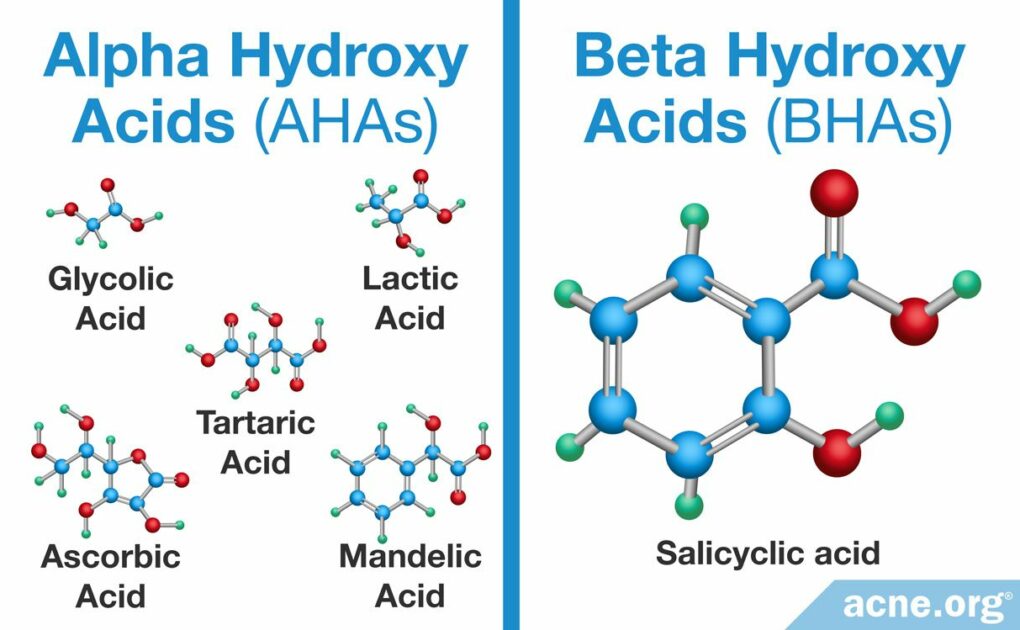AHAs and BHAs are Both Hydroxy Acids Used to Treat Acne, but Differ in How They Affect the Skin

The Essential Info
Alpha hydroxy acids (AHAs) and beta hydroxy acids (BHAs) are acids used to treat a variety of skin diseases, including acne, and are available in:
Over-the-counter Products
- AHAs: Up to 10% strength
- BHAs: Up to 2% strength
Professionally-administered Peels
- AHAs: Up to 70% strength
- BHAs: Up to 70% strength
Examples of Widely-used AHAs: Glycolic acid (most common), lactic acid, mandelic acid
Examples of Widely-used BHAs: Salicylic acid is the only widely-used BHA
How They Work in the Skin: Both AHAs and BHAs act similarly to exfoliate the skin but possess different chemical properties that affect how they act on and in the skin.
Side Effects: AHAs and BHAs come with similar side effects, including skin irritation, stinging/burning, scaling/peeling, dryness/crusting, and redness.
Efficacy on Acne: It appears that both AHAs and BHAs clear acne to a similar degree. However, since neither will completely clear acne on their own, both AHAs and BHAs are often combined with other acne medications.
Efficacy on Post-inflammatory Hyperpigmentation (red/dark marks left over after acne heals): Recent research suggests that at higher concentrations like those used in professional chemical peels, both AHAs and BHAs may significantly reduce hyperpigmentation.
___
A Quick Note: Normally I can boil down all of the essential information from the science up here, but since there are so many small differences and similarities between AHAs and BHAs, there are too many things to list here. So, it’s best to read the full science article below. If you’re pressed for time, just look at the illustrations–they are a good overview.

The Science
- Differences Between AHAs and BHAs
- AHAs and BHAs Work in Similar Ways
- AHAs and BHAs Have Similar Side Effects
- AHAs and BHAs Are Similar in Effectiveness
Hydroxy acids are a group of acids that are used primarily for their ability to exfoliate the skin, and are used to treat a variety of skin conditions, including acne. For the purposes of this article, we will zero in on how they are used for acne. There are two main classes of hydroxy acids:
- Alpha hydroxy acids (AHAs)
- Beta hydroxy acids (BHAs)
The main AHA used to treat acne is glycolic acid, while by far the most common BHA used to treat acne is salicylic acid, and most studies investigating AHAs and BHAs focus on glycolic acid or salicylic acid. In other words, in the real world, when people talk about AHAs and BHAs, they are most often speaking about glycolic acid or salicylic acid.
AHAs are available in over-the-counter products in concentrations up to 10% and in professionally-administered peels in concentrations up to 70%.
BHAs are available in over-the-counter products in concentrations from 0.5% to 2% and in professionally-administered peels in concentrations up to 70%.
Both AHAs and BHAs work mainly by exfoliating the outermost layer of skin, which stimulates the skin to keep turning over.1,2 This helps to clear pores and can also help prime the skin to absorb other medications.
When used on their own, AHAs and BHAs work only to a moderate degree. This is why most dermatologists recommend using them alongside other acne medications, where they can increase the effectiveness of these other medications.
Let’s start by delving into the differences between how AHAs and BHAs work in the skin.
___
Differences Between AHAs and BHAs
There are several differences between AHAs and BHAs, which determine how they work to treat acne.
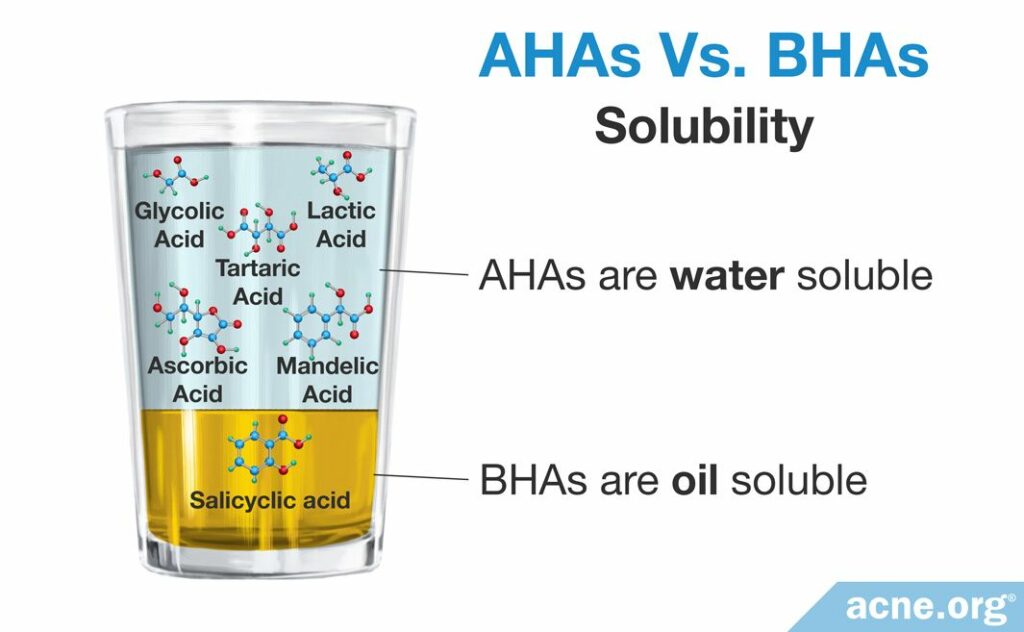
- Solubility: Solubility is a scientific term to describe the ability of a substance to dissolve in another substance.
AHAs: Alpha hydroxy acids are water soluble, which means they dissolve well in water. This is relevant to acne because water-soluble solutions cannot penetrate into oil-filled areas like the inside of a pore, where acne begins, so they can only act on the surface of the skin.
BHAs: Beta hydroxy acids are oil soluble, which means they dissolve well in oil. This is relevant to acne because oil-soluble solutions can enter into the oil-filled pore and act to exfoliate the skin from within the pore.
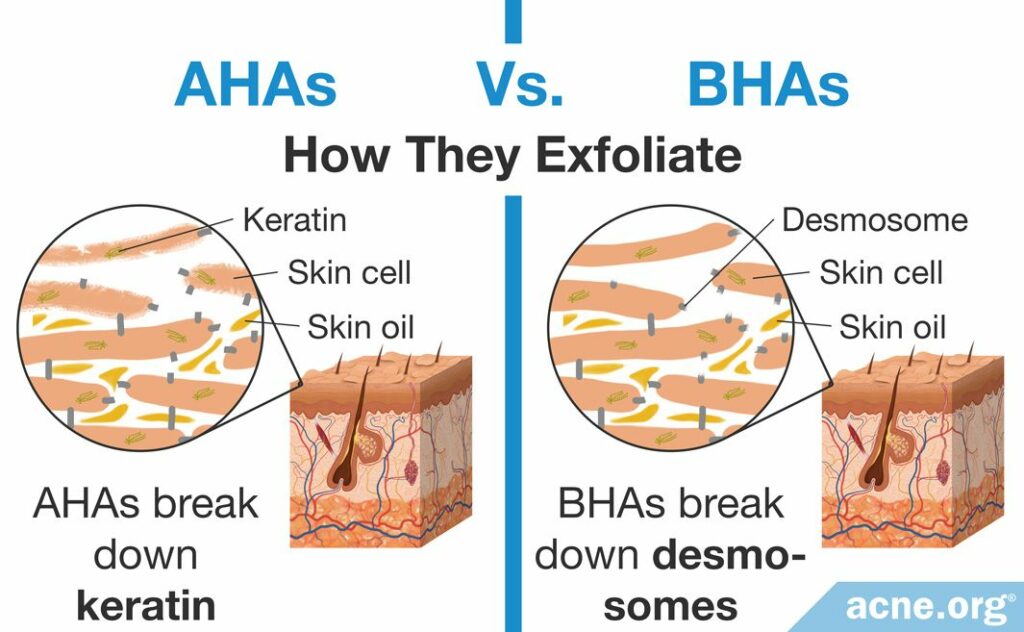
- How they exfoliate: In order to peel the skin–which stimulates skin cells to turn over and helps unclog pores–all hydroxy acids must interact with skin proteins that hold skin cells together.
AHAs: Alpha hydroxy acids break down the sticky protein, keratin. Keratin is an important protein that acts like glue to stick skin cells together. By breaking down keratin, AHAs help “pull” skin cells apart and stimulate peeling of the skin.
BHAs: Beta hydroxy acids act on proteins called desmosomes. Desmosomes stick out of skin cells and act to connect one cell to the next. BHAs break down desmosomes, which helps pull skin cells apart, stimulating peeling of the skin.
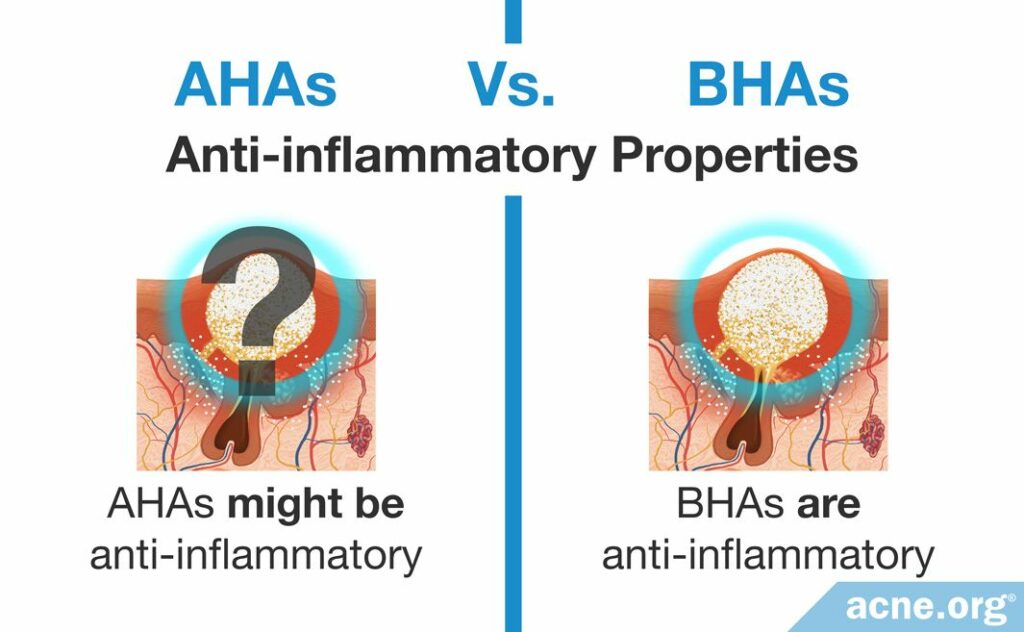
- Anti-inflammatory properties: Inflammation is a major factor in acne, and is present in all stages of acne development. In fact, inflammation is thought to be the trigger that causes acne to develop.
AHAs: The science is not yet conclusive on whether alpha hydroxy acids have anti-inflammatory properties. Some evidence suggests that AHAs might reduce inflammation at lower concentrations but might actually increase inflammation at higher concentrations.3 However, in the real world, a high-concentration AHA chemical peel is something you would only get occasionally in a professional setting. While a temporary increase in inflammation might occur, this is expected when applying a strong acid to the skin and would likely only be short-lived. In other words, it may not be worth worrying too much about the potential increase in inflammation from high-concentration AHAs.
BHAs: Beta hydroxy acids are anti-inflammatory acids, meaning that they can decrease inflammation in acne lesions, which could have some effect on the clearing and prevention of acne lesions.
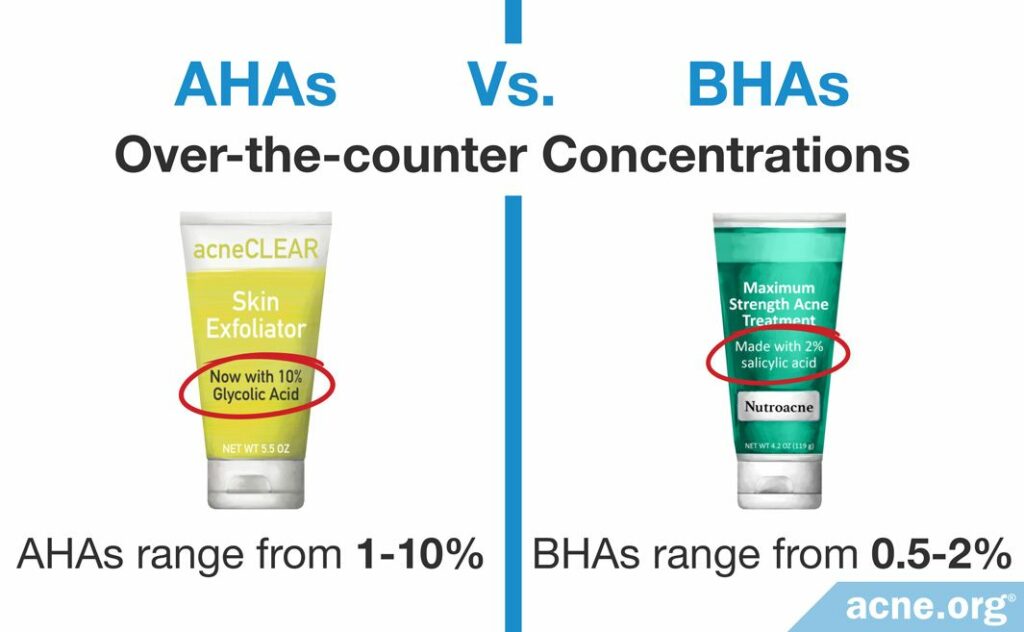
- Over-the-counter concentrations: Both AHAs and BHAs are available in concentrations up to 70% in professionally-administered peels that are administered in settings like doctors’ offices or skincare salons. However, only lower concentrations are safe for use at home in over-the-counter products.
AHAs: Alpha hydroxy acids are available in over-the-counter in concentrations ranging from 1 – 10%. Products containing a concentration greater than 10% should only be administered by a skin care professional like a nurse or esthetician.
BHAs: Beta hydroxy acids are available in over-the-counter products in concentrations ranging from 0.5% to 2%. Products containing a concentration greater than 2% should only be administered by a skin care professional like a nurse or esthetician.
Now let’s have a quick look at the differences between AHAs and BHAs when it comes to effects on the skin in general, outside of acne.
How AHAs and BHAs differ when it comes to effects on the skin in general
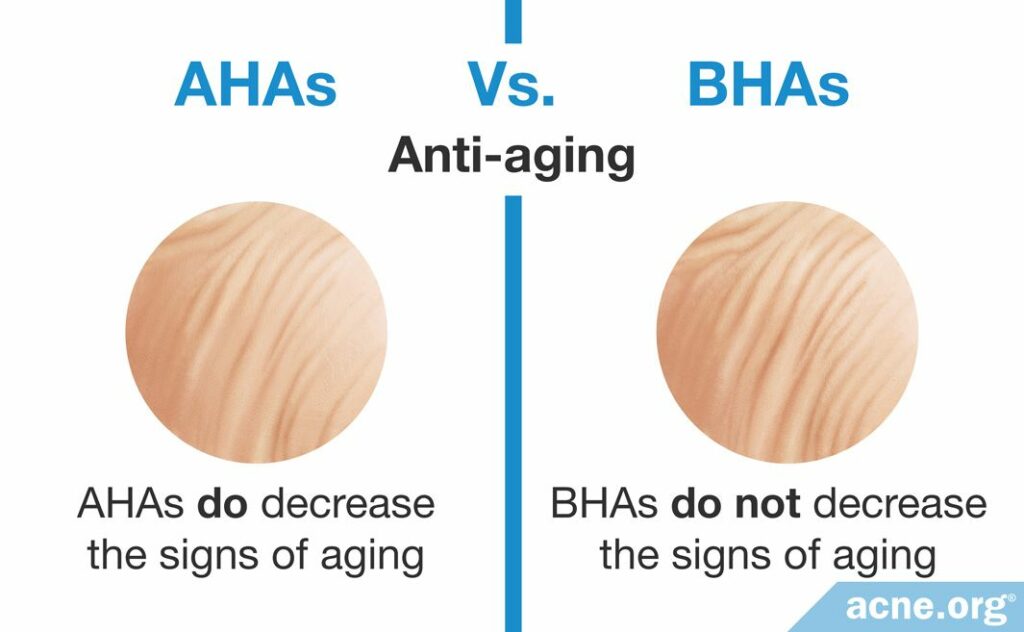
- Anti-aging: The skin contains a matrix of proteins that help support its structure and shape. Collagen is an important protein in this matrix that helps to support the skin. If there is a decrease in collagen, which happens naturally during aging, wrinkles form.
AHAs: Alpha hydroxy acids can increase the production of collagen in the skin, and therefore decrease the signs of aging.
BHAs: Beta hydroxy acids show no anti-aging effects.
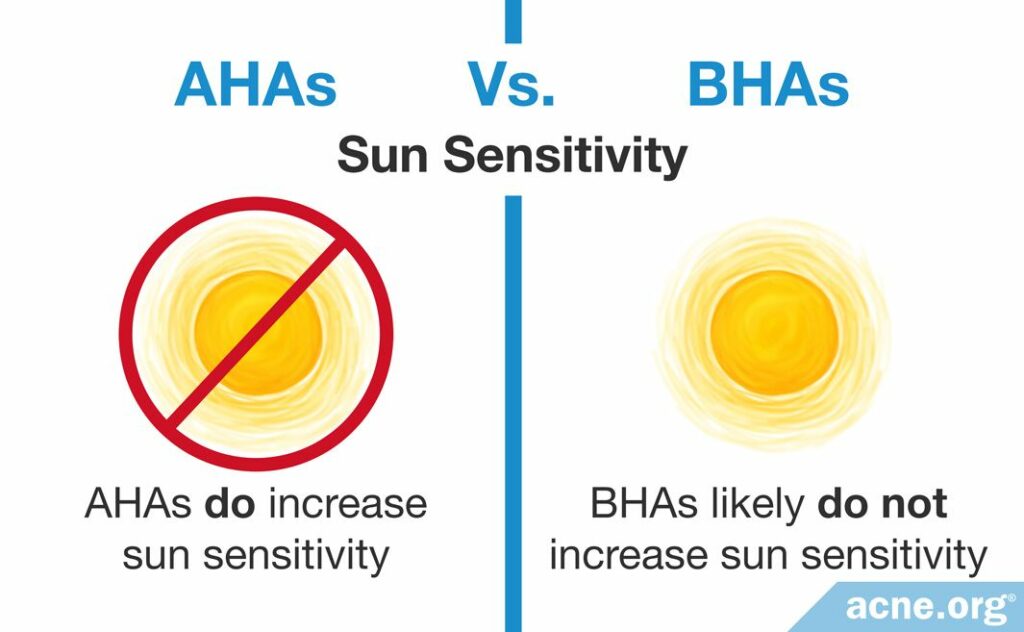
- Sun sensitivity: Since hydroxy acids work by peeling off the top layer of skin, it is thought that they make the skin more sensitive to the sun’s rays. This is important because a sunburn can cause acne in the days and weeks following over-exposure to the sun as the skin repairs itself. The U.S. Food and Drug Administration (FDA) recommends employing some form of sun protection when using either an AHA or BHA. However, research shows this is likely a much bigger concern when it comes to AHAs.
AHAs: Research has clearly shown that AHAs increase sun sensitivity, and therefore sun protection should always be worn when using an AHA.
BHAs: Although BHAs work to thin the top layer of skin, research has found that BHAs do not increase sensitivity to the sun. Despite this finding, the FDA still recommends that people using BHAs practice some form of sun protection just in case peeling of the skin results in sun sensitivity.1,4-7
That’s it for the differences. Now let’s look at some similarities between AHAs and BHAs in how they work to clear acne, their side effects, and their effectiveness.
___
AHAs and BHAs Work in Similar Ways
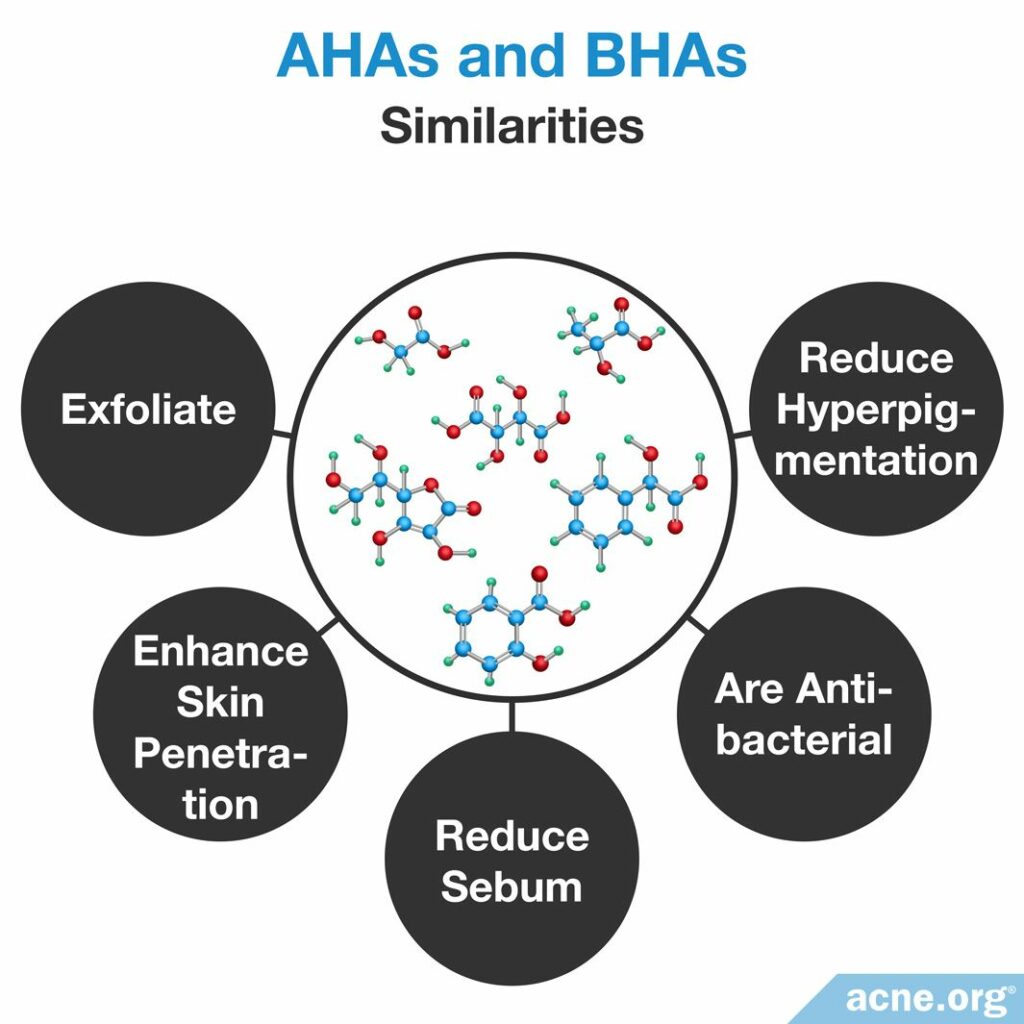
AHAs work to clear acne in similar ways, including:
- Exfoliation: Both AHAs and BHAs impact acne by exfoliating the top layer of skin, which helps to unclog clogged pores and prevent the formation of new ones.
- Skin penetration: Both AHAs and BHAs can enhance the penetration of other medications. So, even though they don’t produce dramatic results on their own, when combined with other medications, they are known to “turbo-charge” results.
- Reducing skin oil (sebum): Acne-prone individuals often produce more skin oil, called sebum, than non-acne-prone individuals. This excess sebum accumulates in clogged pores and leads to acne. Both AHAs and BHAs work to decrease sebum.5-7
- Antibacterial properties: One factor involved in the development of acne is acne bacteria, called C. acnes, which grows inside clogged pores and can make acne worse by increasing inflammation and triggering the development of pus. Both AHAs and BHAs have antibacterial properties, which can help clear C. acnes from clogged pores and help prevent the worsening of acne.
- Reducing hyperpigmentation: When an acne lesion heals, it can leave behind red/dark marks on the skin. These marks are called post-inflammatory hyperpigmentation, or hyperpigmentation for short. Both AHAs and BHAs can decrease hyperpigmentation by stimulating the growth of new skin cells, which replace the old, discolored skin cells and improve the appearance of the skin.
AHAs and BHAs Have Similar Side Effects
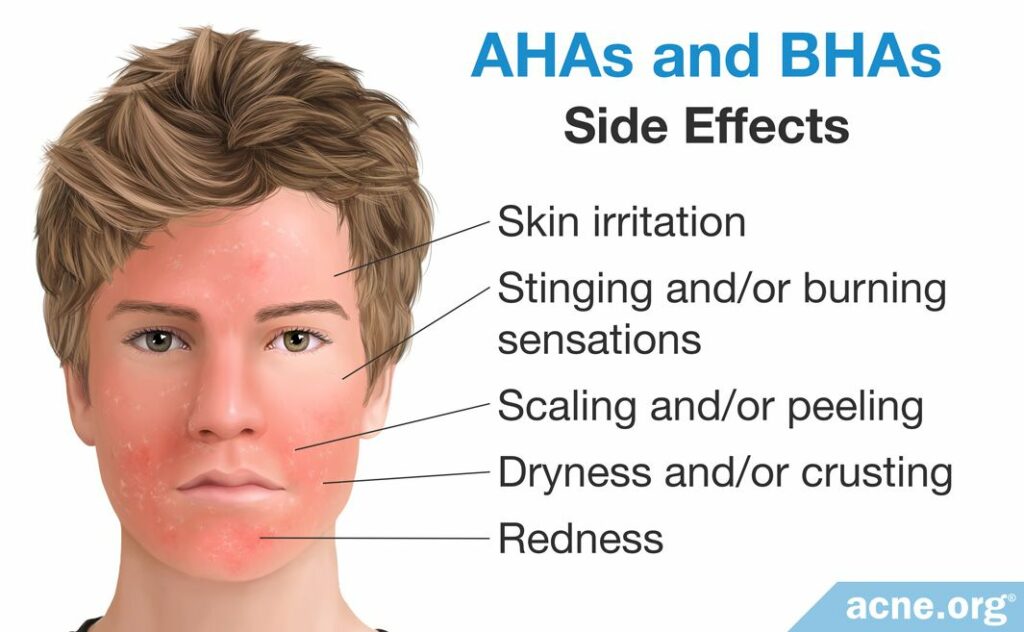
The side effects of AHAs and BHAs are similar and generally mild. Over-the-counter products, which are used at lower percentages, cause less of these side effects, while professionally-administered peels using AHAs and BHAs as higher concentrations cause much more noticeable side effects. These side effects include:
- Skin irritation
- Stinging and/or burning sensations
- Scaling and/or peeling of skin
- Dryness and/or crusting of skin
- Redness
- Sun sensitivity2,8
The following illustration portrays side effects that can be expected from professionally-administered peels. Over-the-counter products can produce these type of effects as well, but to a lesser degree.
AHAs and BHAs Are Similar in Effectiveness
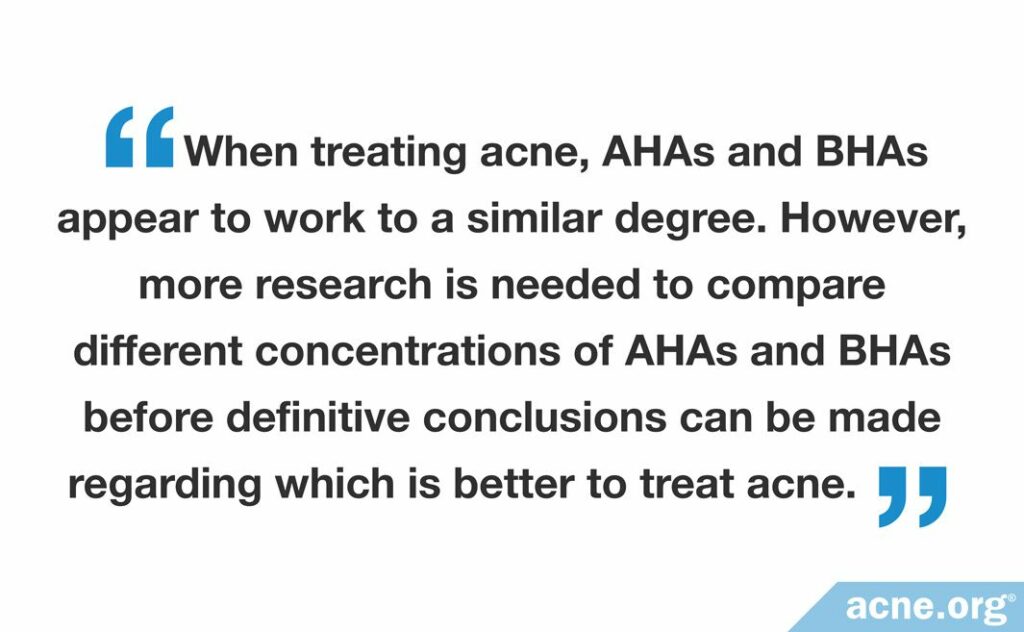
Scientists have performed 5 studies directly comparing the effectiveness of AHAs vs. BHAs on acne. Using this data, we can see that AHAs and BHAs appear to work to a similar degree. However, more research is needed to compare different concentrations of AHAs and BHAs before definitive conclusions can be made regarding which is better to treat acne.
Expand to read details of these 5 studies

A 2008 study published in Dermatologic Surgery compared the efficacy of a 30% glycolic acid peel with that of a 30% salicylic acid peel. To perform this study, the researchers conducted a split-face treatment, meaning that they applied the glycolic acid peel to half of the face, and the salicylic acid peel to the other half of the face, in 20 patients. Each patient underwent a total of 6 peels, performed every 2 weeks. The researchers found that 2 months following treatment, 75% of the glycolic acid-treated skin and 81% of the salicylic acid-treated skin showed good or fair improvement of mild to moderate acne. Although the salicylic acid peel performed slightly better, more patients considered the glycolic acid peel to display a better efficacy, meaning that they perceived that the glycolic acid peel worked better than the salicylic acid peel.4
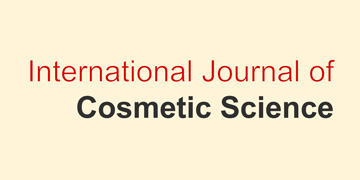
A 2004 study published in the International Journal of Cosmetic Science compared the efficacy of a 2% lactic acid (a type of AHA) treatment with that of a 2% salicylic acid treatment on acne. To perform this study, the researchers had 90 participants apply the acid products twice daily over the course of 12 weeks. The researchers found that lactic acid was slightly more effective than salicylic acid at reducing comedones.9

A 2011 study published in the Journal of the European Academy of Dermatology and Venereology compared several independent AHA and BHA studies in order to draw conclusions regarding the ability of glycolic acid and salicylic acid to clear acne. This research found that 30% glycolic acid peels resulted in 75% of patients reporting good improvement of acne, while a 30% salicylic acid peel resulted in a 75% reduction of lesions. Although these 2 measurements cannot be equally compared, as one measures patient opinion and the other measures reduction of acne lesions, it is clear from these results that both 30% glycolic acid and 30% salicylic acid are effective, to some extent at clearing acne.1
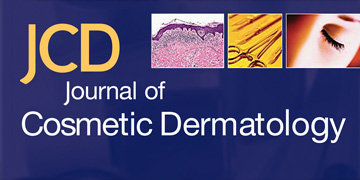
A 2019 study published in the Journal of Cosmetic Dermatology compared the efficacy of a 45% mandelic acid peel, a type of AHA, with a 30% salicylic acid peel, which is a BHA, in 50 Indian patients with mild-to-moderate acne. The researchers randomly divided the patients into 2 groups, and patients in the first group received the AHA peel, while patients in the second group got the BHA peel. Each patient received 6 peel sessions at intervals of 2 weeks. The researchers found that the 2 peels were equally effective overall, but mandelic acid was better at treating inflammatory lesions, while salicylic acid was better at treating non-inflammatory lesions. The researchers also concluded that the mandelic acid peel was safer and less likely to cause temporary skin burning, stinging, or redness than the salicylic acid peel.10

A 2019 study published in the Journal of Cutaneous and Aesthetic Surgery compared the efficacy of 2 different AHA peels as well as a combination AHA+BHA peel for the treatment of acne and post-inflammatory hyperpigmentation. A total of 45 patients were divided into 3 groups:
- Group 1 underwent peels with 35% glycolic acid, an AHA.
- Group 2 underwent peels with phytic acid, another AHA.
- Group 3 underwent peels with a combination of 10% mandelic acid, an AHA, and 20% salicylic acid, a BHA.
Each group received 6 chemical peels spaced 2 weeks apart. In a follow-up visit after all the treatment sessions were completed, the researchers examined the patients’ skin for acne lesions and hyperpigmentation. They found that each type of peel significantly reduced acne: by 70.55% in Group 1, 69.7% in Group 2, and 74.14% in Group 3. They also found that hyperpigmentation decreased in all patients. Therefore, the researchers concluded that all 3 peels were equally effective for treating mild-to-moderate acne and hyperpigmentation.11
References
- Dréno, B. et al. Efficacy of superficial chemical peels in active acne management – What can we learn from the literature today? Evidence-based recommendations. J Eur Acad Dermatol Venereol 25, 695 – 704 (2011). https://www.ncbi.nlm.nih.gov/pubmed/21029205
- Kornhauser, A., Coelho, S. G. & Hearing, V. J. Applications of hydroxy acids: classification, mechanisms, and photoactivity. Clin Cosmet Investig Dermatol 3, 135 – 142 (2010). https://www.ncbi.nlm.nih.gov/pmc/articles/PMC3047947/
- Tang, S. C. & Yang, J. H. Dual effects of alpha-hydroxy acids on the skin. Molecules 23, 863 (2018). https://pubmed.ncbi.nlm.nih.gov/29642579/
- Kessler, E., Flanagan, K., Chia, C., Rogers, C. & Glaser, D. A. Comparison of α- and β-hydroxy acid chemical peels in the treatment of mild to moderately severe facial acne vulgaris. Dermatol Surg 34, 45 – 51 (2008). https://www.ncbi.nlm.nih.gov/pubmed/18053051
- Yu, R. J. & Van Scott, E. J. Alpha-hydroxyacids and carboxylic acids. J Cosmet Dermatol 3, 76 – 87 (2004). https://www.ncbi.nlm.nih.gov/pubmed/17147560
- Arif, T. Salicylic acid as a peeling agent: a comprehensive review. Clin Cosmet Investig Dermatol 8, 455 – 461 (2015). https://www.ncbi.nlm.nih.gov/pubmed/26347269
- Decker, A. & Graber, E. M. Over-the-counter acne treatments: A review. J Clin Aesthet Dermatol 5, 32 – 40 (2012). https://www.ncbi.nlm.nih.gov/pubmed/22808307
- Babilas, P., Knie, U. & Abels, C. Cosmetic and dermatologic use of alpha hydroxy acids. J Ger Soc Dermatol 10, 488 – 491 (2012). https://www.ncbi.nlm.nih.gov/pubmed/22916351
- Scherdin, U. et al. In vivo assessment of the efficacy of an innovative face care system in subjects with mild acne vulgaris. Int J Cosmet Sci 26, 221 – 229 (2004). https://onlinelibrary.wiley.com/doi/abs/10.1111/j.1467-2494.2004.00225.x
- Dayal S., Kalra K. D., Sahu P. Comparative study of efficacy and safety of 45% mandelic acid versus 30% salicylic acid peels in mild-to-moderate acne vulgaris. J. Cosmet. Dermatol. (2019) Sep 25. doi: 10.1111/jocd.13168. [Epub ahead of print] https://www.ncbi.nlm.nih.gov/pubmed/31553119
- Sarkar, R., Ghunawat, S. & Garg, V. K. Comparative study of 35% glycolic acid, 20% salicylic-10% mandelic acid, and phytic acid combination peels in the treatment of active acne and postacne pigmentation. J Cutan Aesthet Surg 12, 158-163 (2019). https://pubmed.ncbi.nlm.nih.gov/31619887/
 Acne.org Products
Acne.org Products